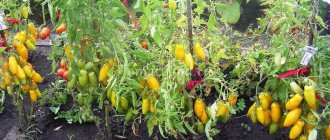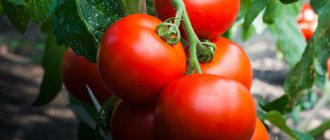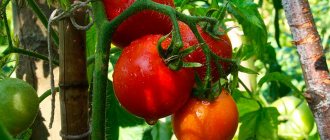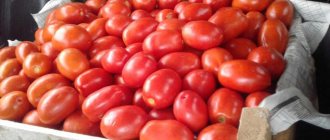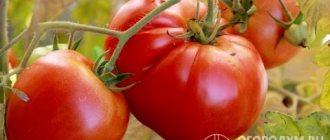Vegetable growers who live in areas of problematic agriculture especially value varieties and hybrids of vegetable crops that can be grown in open ground and at the same time obtain good yields of fruits with a pleasant taste. This also applies to tomatoes, new varieties and hybrids of which are grown annually by breeders for regions with a short summer cold period.
One of these new tomato varieties that can be grown in regions with problematic agriculture is the Klusha tomato and its improved version, the Superklusha tomato.
Description of the variety
The main characteristics and descriptions of the tomato varieties Klusha and Super Klusha are the same. In principle, this is the same culture. The only difference is the color of the fruit and, of course, their taste. But let's start the review with the ripening period. Klush tomatoes ripen very early. From the moment of sowing the seeds, approximately 90 days will pass, and the fruits will already be red in the garden, hanging in large clusters.
The plant is considered to be of a determinate type. The structure of the bush is standard. The stems grow to a maximum of 60 cm in height. An adult tomato bush is so compact that up to 7 plants can be placed in a 1 m2 bed. Chum can even be grown on a windowsill or balcony. The culture bears fruit well in a flower pot suspended using a flower pot.
You can guess the origin of the name of the variety by the structure of the bush. If you look at the Super Klusha tomato from the outside, its shape resembles a chicken with splayed feathers. The fruits hidden under the leaves can be compared to chickens. The plant is a master of hide and seek. Ripening tomatoes are almost invisible under the foliage. The bush is distinguished by its dense green mass. The leaf structure is normal, like all tomatoes.
Advice! To ensure quick and uniform ripening of fruits, vegetable growers recommend plucking off the leaves that cover the clusters from the sun.
The manufacturer, in the description of the Klusha tomato variety, indicates that the crop can be grown in all regions of our country. Breeders have instilled good immunity to fungal and viral diseases in tomatoes. The optimal yield of Klushi and Super Klusha is achieved when the bush is formed with several stems. Their number can be from 2 to 4.
Important! The standard Klusha tomato bush forms itself and does not require the removal of stepsons.
The compact bush is characterized by powerful stems that do not require tying to a trellis. But if you read reviews about the Super Klusha tomato, vegetable growers strongly recommend putting supports under the branches with fruits.
Advantages and disadvantages
The line of Klusha tomatoes is loved by summer residents for the numerous “advantages” of the varieties.
Advantages and disadvantages
Early ripening
Excellent taste (subject to ripening on the bushes)
Universal use
Productivity (according to the “Golden Klusha” variety)
Grows wonderfully in open ground, in boxes and pots on loggias and balconies.
Ability to harvest seeds
Easy care
High immunity, resistance to fungal diseases and adverse factors
No cracked fruits (even with irregular watering)
Not suitable for storage
Poor keeping quality
These tomatoes are created for those who, due to circumstances, cannot devote much time to planting. Unpretentious and resistant to natural vagaries, the varieties successfully bear fruit even in an unfavorable season for the crop and are suitable for growing by beginning gardeners.
Fruit characteristics
Photos about the Klusha tomato, reviews from gardeners form the opinion that the crop is a decoration of the garden bed. The fruits are characterized by a round shape. The upper part and the wall at the place where the stalk is attached are slightly flattened. The Klusha variety has a predominant red fruit color, while Super Klusha tomatoes acquire a pink tint when ripe. The pulp of both varieties of tomato is sweet, juicy and very tasty when eaten fresh. Inside the fruit there can be up to 7 chambers with seeds.
Despite the small size of the bush, the yield rate is up to 3 kg of tomatoes per plant. Klusha loves to comply with the conditions of agricultural technology. The crop will reward you for good care with fruits weighing up to 150 g. Under unfavorable conditions for the tomato, the yield may decrease. The fruits will become smaller, as their weight will decrease to 100 g.
Important! During a decrease in yield, only a loss of fruit weight is observed, and their number remains unchanged. That is, the intensity of ovary formation does not decrease.
Ripe fruits are considered to have a universal purpose. Tomatoes are suitable for fresh consumption. They are used to make salads and decorate dishes. According to reviews from vegetable growers, it is the pink fruits of the Super Klusha variety that are considered tastier. Red tomatoes of the Klusha variety are slightly inferior in taste. However, a ripe vegetable is also good for fresh salads. Red and pink fruits are used for preservation. The dense pulp, protected by a strong skin, does not crack during heat treatment.
Attention! Tomatoes can be stored for a long time, only they need to be picked slightly unripe. The fruits tolerate transportation well.
Reproduction methods
Super Klusha tomatoes (the description of the variety and photos indicate its productivity) reproduce only by seeds. And since they are not hybrids, you can get viable material from the first harvest.
You can do it this way:
- When the tomatoes just begin to ripen and turn brown, cut off the strongest fruits on the bottom cluster. Place the tomatoes on newspaper in a warm place away from direct sunlight. You should not use ripe fruits for propagation, since the seeds of such tomatoes can germinate in the fall and die.
- When the fruits turn pink, cut them and remove the pulp and seeds.
- Transfer the mixture into a glass jar and cover with gauze. Leave to ferment in a warm place, protected from sunlight, for 2-3 days.
- When the time comes and the grains sink to the bottom, rinse them to remove any remaining pulp.
- Spread the seeds on newspaper and dry completely in a well-ventilated, warm and shaded place.
It is better to keep planting material in paper or cotton bags. It remains viable for 4-5 years.
Positive features of the variety
Considering the yield of the Super Klush tomato, reviews, photos, let’s sum up the main advantages of the variety:
- a small bush can fit on a small plot of land;
- high yield;
- independent formation of the bush, which does not require the removal of stepsons;
- Klushi fruits are universal in use;
- plant resistance to diseases;
- the possibility of growing tomatoes in any region of the country.
Vegetable growers did not identify any deficiencies in the Klusha and Super Klusha varieties. This can only be attributed to the strong thickening of the foliage, but in the hot summer it will save the fruits from being burned.
Prevention of diseases and pests
The plant can be protected from fungal diseases with biofungicides, but this is not necessary. Fitisporin is considered the most effective. In addition to its antifungal effect, it is also a source of foliar fertilizers that improve and strengthen the health of tomatoes.
The product does not cause problems, so it can be used repeatedly, even during fruit harvesting, because it is considered absolutely safe for all living beings.
Choosing a place to plant tomatoes
To get a good harvest, tomatoes need to be planted in a prepared area. The bed must be allocated, even if the tomatoes are grown in the garden. Klusha has a low-growing bush structure, so plants can be planted in holes. Although, many gardeners prefer to dig long ditches. Tomatoes are arranged in rows more neatly and are easier to care for.
The Klusha and Super Klusha varieties can be grown not only openly, but also indoors. The tomato bears fruit well in any type of greenhouse, be it film cover, glass or polycarbonate. It is only important to provide the tomatoes with good lighting and regular ventilation.
With any method of growing Klush tomato, care must be taken to ensure good soil drainage. The culture loves abundant watering, but water should not stagnate under the roots. Otherwise, disease outbreaks may occur. Late blight will appear or plant roots will begin to rot.
Klusha tomatoes, video
If you grew Klush tomatoes, please write whether you liked them or not. What was the yield and taste of the fruit? Will you grow them again? How do you rate the disease resistance of this variety? What advantages and disadvantages did you see in this tomato? If possible, attach a photo of the fruits you grew to your comment. Thank you!
Your reviews of the Klusha tomato and additions to the description will help many gardeners evaluate this variety more objectively and decide whether it is worth planting or not.
You can see other interesting varieties and hybrids of tomatoes with photos, descriptions and reviews in our Tomato Catalog. Enjoy watching.
Preparing soil for seedlings
In most regions, tomatoes are grown from seedlings. Only in the south is it possible to sow seeds directly into the garden bed. To grow Klusha or Super Klusha tomato seedlings, you first need to prepare the soil. Despite the saturation of store-bought soil with useful minerals, many vegetable growers prefer to collect soil from the garden for seedlings. You can do it this way, you just need to disinfect it. It is recommended to bake the soil in the oven and then take it out into the fresh air. Outside, the soil will be saturated with oxygen for two weeks.
Before sowing the seeds, the soil is brought into the house so that it warms up to room temperature. At this time, another disinfection is performed. A solution is prepared from 2 liters of water and 1 g of manganese and the soil is evenly moistened with this liquid.
Seed preparation
Klusha tomato seeds are sown for seedlings in March. By this time the grains need to be prepared:
- The percentage of seed germination depends on calibration. First, the tomato seeds are visually inspected for damage and all suspicious seeds are discarded. The following procedure involves immersing tomato seeds in a saline solution. All floating pacifiers are thrown away, and the full grains that have settled to the bottom of the container are washed with clean water.
- Tomato seed dressing is carried out in a 1% manganese solution. It is enough to dip the grain for 20 minutes. Many vegetable growers use the juice of an indoor Aloe flower instead of potassium permanganate. In addition to its disinfecting properties, the juice is a growth stimulant.
The last stage involves germinating tomato seeds. To do this, scatter the grains between two layers of damp gauze and make sure they do not dry out. Tomato seeds are periodically sprayed with water until the sprouts hatch.
Sowing seeds and obtaining seedlings
After all the tomato seeds have sprouted, they need to be planted immediately. By this time, containers with soil should be prepared. On the surface of the ground, any object or finger makes grooves 1 cm deep. The distance between rows is maintained within 2–3 cm. Tomato seeds are laid out in 3 cm increments, after which they are sprinkled with loose soil on top and sprayed with water.
The containers are covered with transparent film. In this state, they stand at an air temperature of +25 ° C until seedlings appear. After the tomatoes germinate, the film is removed and the seedlings are provided with good lighting. When two full leaves grow on the tomatoes, the plants are planted in cups and fertilized on the third day.
Planting dates and cultivation characteristics
Planting and further growing the Superklush tomato is basically no different from growing other varieties of tomatoes. However, there are some features of growing seedlings of this tomato and further caring for adult plants, which vegetable growers need to know about before starting planting work.
Growing seedlings
The Superklusha tomato is grown in seedlings, like most other tomato varieties. Seed material is planted approximately 50 days before transplanting into garden beds - in the second ten days of March.
Superklushi seeds for planting are usually bought in specialized stores - most often they are sold by the agricultural company Siberian Garden. If vegetable growers have already grown this tomato, then they can collect seed material from ripened tomatoes.
Just before planting, they should be calibrated - placed in a container with salt water and thrown away those that float to the surface - they will not germinate. And those that have sunk to the bottom should be placed in a weak solution of potassium permanganate for disinfection for an hour or two. Then the seeds are washed and dipped in a solution with growth accelerators for germination.
After the seed material germinates, it is planted in long, wide containers with low sides filled with nutrient substrate. Shallow trenches are made in it, into which the seeds are laid out. The furrows are sealed with earth, watered with a spray bottle, the top of the containers is covered with polyethylene and placed in a warm, bright place until the seed material germinates.
After the sprouts appear, the polyethylene is removed and the plants are moved to the windowsill. When the plants have a pair of true leaves, they are picked into separate cups.
During cultivation, seedlings need to be fed with nitrogen-containing fertilizers at least 2 times.
10-12 days before transplanting to garden beds, seedlings begin to harden off. The seedlings are transplanted to a permanent location when at least 5 true leaves appear on them.
Transplantation into the ground
The beds at the planting site should be prepared in advance - in the fall, removing remnants of vegetation and applying fertilizers. After this, the area is dug up, incorporating fertilizers into the soil.
In the spring, seedlings are transplanted into garden beds - in the second ten days of May under film coverings, in early June - directly into the soil. Up to 5-6 Superclushi bushes are planted on each square of area.
Further care
Further care for the bushes of this tomato consists of regular watering, fertilizing, loosening the soil and tying up the shoots.
Tomato bushes are watered depending on the climatic conditions of the growing region. Typically, watering is carried out once every 5-7 days. In hot, dry weather the amount of watering is increased, and during the rainy season it is reduced.
Water for irrigation should be settled and warm enough. You should not experiment and water your tomatoes either with too cold or too warm water - this will cause the plants to get sick, their development will slow down, and the yield will be much lower.
After watering or rain, it is recommended to loosen the root zones of the bushes to break up the dry crust that appears. At the same time, remove all emerging weeds.
Fertilizers are applied regularly throughout the season. In the spring, tomatoes are fed with urea, a solution of mullein or bird droppings. After the start of flowering, Superklusha tomato bushes should be fed with a mixture of superphosphate and potassium salt. Such fertilizers promote the active appearance of flowers and ovaries, accelerate the growth of fruits, and improve their taste.
Planting to a permanent place of growth
Adult tomato seedlings are hardened off before planting. Tomatoes are taken outside when the air temperature is not lower than +18°C. It is advisable to carry out such procedures for about a week. Planting of the Klushi tomato begins at 50–60 days of age. By this time, the plants stretch up to 30 cm in height.
The time for planting tomatoes in a greenhouse falls in the first ten days of May. In the garden, Klush tomatoes are planted after warm weather sets in and the soil warms up. For the middle zone, this period begins in the last days of May. The variety Super Klusha and Klusha love loose, well-fertilized soil. It is better to let the acidity be slightly increased than decreased. As a last resort, a neutral indicator is allowed. Determinate tomatoes do not stretch, so when planting seedlings, you should not deepen the roots. It is optimal to plant five bushes per 1 m2.
Caring for adult tomatoes
The Klusha variety does not require special care. Timely watering, weeding, and loosening the soil are important. 3 weeks after planting the seedlings, the tomatoes are fed with nitroammophos fertilizer. The bushes do not require pinching. But if the plants themselves are poorly formed, the vegetable grower can help. The bushes are helped to form 2–4 stems by breaking off unnecessary stepsons. In case of severe thickening, part of the foliage is removed from the tomato.
When growing Klushi in a closed way, during flowering the air humidity is reduced for better pollination. At the same time, the air temperature is kept to a maximum of +28°C.
The video talks about tomatoes for open ground:
It is better to start harvesting when the fruits just begin to turn red or pink. For long-term storage, you can wrap each tomato in soft paper and place it in boxes.
Reviews from gardeners
Elena, 44 years old, Barnaul
This variety, in my opinion, is not very productive. When I was calibrating the seed material, I disinfected it in potassium permanganate. then from each low bush I received no more than 2 kg of tomatoes. These bushes do not require planting, but it is necessary to remove the stepsons, form the plant into 2-3 stems, then each bush can produce 2.5 kg of ripe fruits.
Galya, 50 years old, Penza
I grow this variety in seedlings; I plant up to 7 low bushes on each square of area. The plants do not require special care; it is only important to water the bushes as the soil dries. Watering is carried out in the evenings strictly at the root, so that drops of moisture do not fall on the foliage. The fruits grow quite large - 110-120 g, and can be used for food and preservation.
Sveta, 48 years old, Moscow region
I got used to growing this variety on my balcony, since we don’t have a dacha. The balcony faces the south, so I grow seedlings at home in separate pots, and when it gets warm, I transfer them to the balcony. I water the plants regularly, but I have to apply fertilizer more often, since there is not much soil in the containers, so the tomatoes quickly extract nutrients from it. The yield was not bad for such small bushes - I collected 1.5 kg from each.
